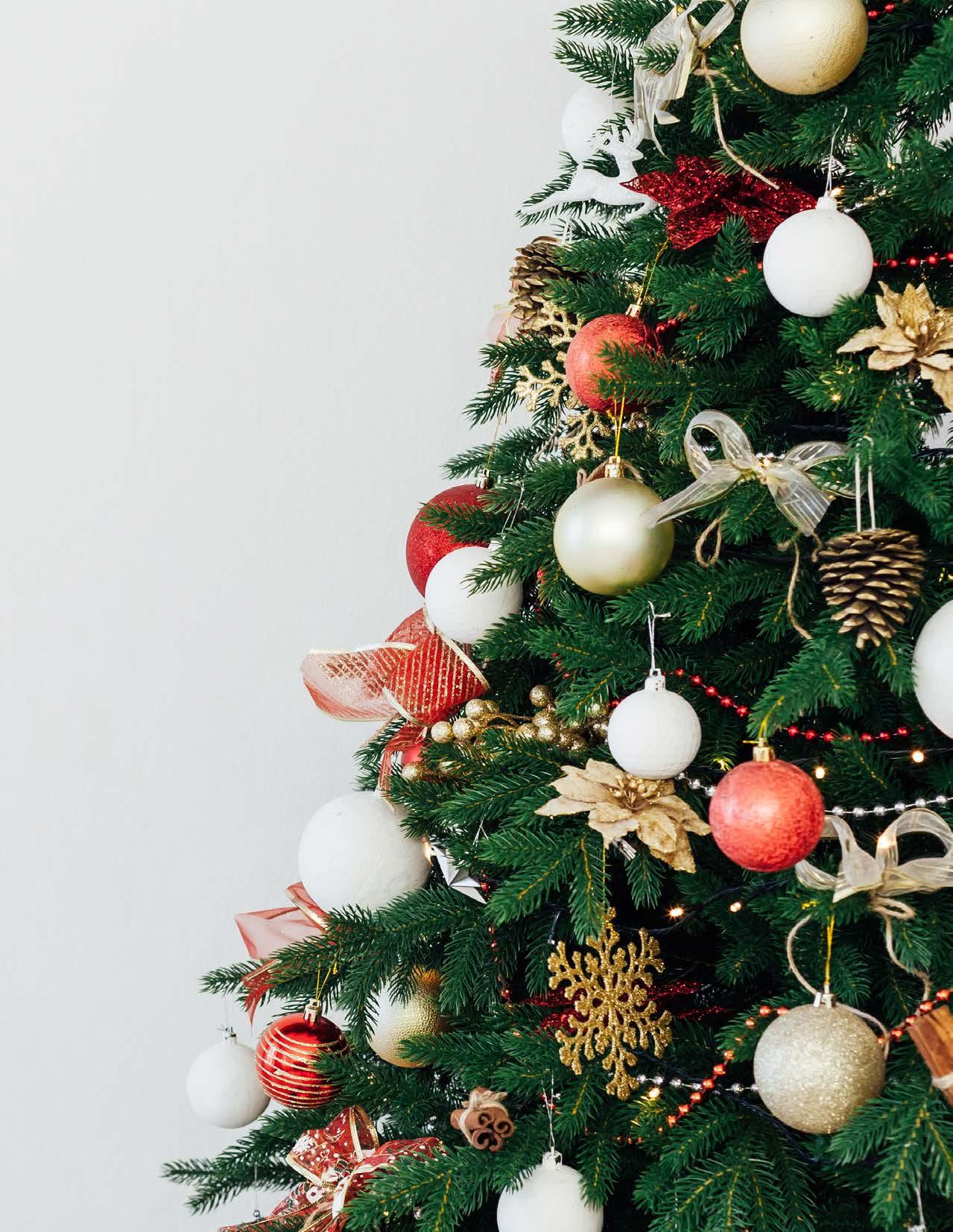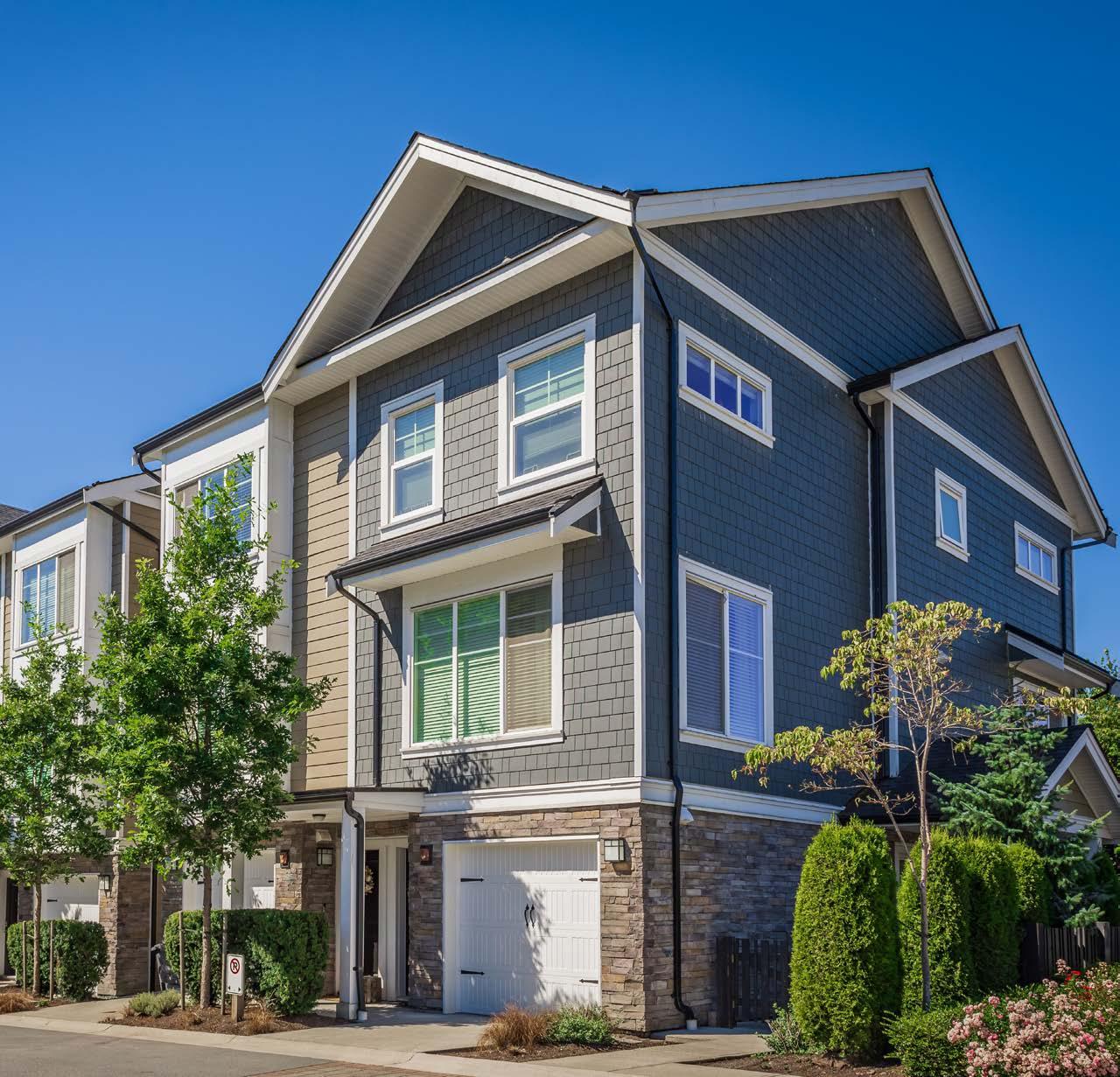
8 minute read
Decorating Your Christmas Tree
TOP TIPS FOR Decorating Your Christmas Tree LIKE A PRO
Decorating a Christmas tree is a time-honored tradition for families all over the globe. What better way to celebrate the holiday season than by cozying up with friends and family by a beautifully decorated tree? That is why we want to gift you with the tools you need to dress your tree like a pro! Let’s start off with the actual tools and items you’ll need to get the job done. If you have some of these items lying around already, get creative and see if they will work! Your tree doesn’t have to be perfect, it’s just about making a tree that represents you. And you might just save a few bucks in the process. Keep reading to see our recommendations. • Lights • Garland/ribbon • Various ornaments
WHAT YOU'LL NEED:
(personal ones too if you want!) • Tree skirt • Topper • Gardening gloves • Fabric scissors • Heavy duty scissors • Step stool
STEP 1. GATHER THE FAMILY Decorating the tree is a family affair by nature. Gather the people closest to you to take part in this special tradition and maybe make a batch of cookies and play some holiday music to set the vibe. STEP 2. CHOOSE A THEME Deciding the theme of your tree will set the stage for the rest of your decorations. Whether you like a traditional look, minimalist, maximalist, monochrome, or sentimental, choose what will best represent YOU. Be sure to look at how you have decorated the rest of your home, what items you already have access to, and the flexibility of your budget. STEP 3. DECIDE ON YOUR TREE Don’t let your Christmas Vacation-sized dreams make your eyes bigger than your living room when it comes to the tree. Be realistic about what will fit in your home and don’t forget to account for a tree topper and your front door. You will also need to decide whether you are going to get a real tree or go artificial. Real trees take far more upkeep, only last one year, and may be a fire hazard, but nothing beats that smell of real pine! Choose the size, type, and theme that best suits your needs. We do recommend staying away from trendy designs for artificial trees like inverted trees, overly sparse trees, or trees with artificial color. These trends are sure to fade out soon and you just might regret having it next year! STEP 4. SHOP FOR DECORATIONS Now that you know the size and theme for your tree, it’s time to shop for decorations. You will need approximately 80 decorations for a 7.5 ft tree to decorate it properly. We recommend picking up lights, garland or ribbon, various ornaments of different sizes (but stick to one theme!), a subtle tree skirt, and a tree topper to finish the look. Picking a core color, like red, with neutral accents, like black, white, or nude, can instantly bring a sense of togetherness to your tree. Be sure to aim for color matching, even with your metallics as trying to pair differing shades or saturations will be noticeable. STEP 5. PREP THE TREE Bringing your tree home isn’t the final step before you start decorating. Prepping through fluffing and shaping can make all the difference for a thicker, fuller, more natural-looking tree. Now is the time to put on those gloves to protect your hands from any extra pointy branches. For both natural and artificial trees, start from the bottom and work your way up, slowly separating the branches from one another. Position each branch individually and don’t let it look too uniform. If you have an artificial tree, you might even want to bend the branches a bit to make it look more natural. For real trees, take out the heavy-duty scissors and trim away any obviously out-of-place pieces. STEP 6. DECORATE! Arguably the most fun part, there is more strategy to putting decorations on a tree than you might think. A. LIGHTS This will be your base layer and will be what makes your Christmas tree glow from the inside out. Start at the bottom where the lights will plug into the wall. Slowly wrap the lights around the tree, weaving them above and below the branches as you go. Once you reach the top, weave the lights back down to add layers. B. GARLAND Garland comes in all shapes and sizes. Our favorites are ribbon and beads. Don’t feel forced to use just one! Using a couple different types of garlands can add additional layers and texture to your tree. Start your garland at the top and work your way down, ensuring your garland is closer to the tips of the branches than the lights. C. ORNAMENTS No matter your theme, good ornaments are a necessity. Once you have yours picked out and purchased, it’s time to start hanging them on the tree. Put the largest ornaments between the bottom and the middle of the tree and the smaller, more delicate ones toward the top. Alternate colors, patterns and finishes so that the tree looks balanced. Put your favorite or more sentimental ornaments on places where they will be seen, at eye level on the front of the tree.
D. TREE PICKS This one is optional but can add that special touch that takes your tree from pretty to professional. Tree picks can come in many different styles from pinecones to berries to metallic branches. They are a great way to add a little color and dimension if your tree is feeling flat. E. TREE SKIRT If you want to perfect that HGTV Christmas cover look for your tree, a tree skirt is essential. Depending on your theme, we recommend a subtle color and pattern that won’t take away from the rest of the tree. Don’t forget to account for the size and type of tree. F. TREE TOPPER The best step is saved for last. Hopefully, you accounted for your topper when picking out your tree. If you did, now it’s time to pull out the step stool and a friend to steady you as you place it right on top.
The real way to finalize your tree is by lighting it with family and surrounding it with gifts and smiles. No matter the final results, that tree is yours and full of special memories you can take with you for next year.

Why You Should Consider CONDOS
as Part of Your HOME SEARCH
The historically low inventory over the past few years led to challenges for many buyers trying to find a home that met their needs and their budget. If you’re in the same boat, you should know the recent shift in the housing market may have opened up doors for you to restart your search.
The inventory of homes for sale has increased this year, and that’s giving buyers much needed options. As Danielle Hale, Chief Economist at realtor.com, says:
“. . . today’s shoppers have more than 5 homes to consider for every 4 they had at this time a year ago.”
But perspective is important. Overall, housing supply is still low. If you need even more choices, expanding your search by adding additional housing types, like condominiums, could help.
Exploring Condos Could Add Options That Fit Your Budget
One thing to consider is condos generally differ from single-family homes in average space and floorplans. But that size difference is one reason why condos can be a more affordable option. According to a recent report from realtor.com, condo buyers paid roughly 7% less for their home than buyers of other housing types last year. With rising mortgage rates and home prices, the relative affordability of a condo could be worth considering.
Remember, your first home doesn’t have to be your forever home. The important thing is to get your foot in the door as a homeowner. Buying a condo now can springboard you into a bigger home later on. An article from the Urban Institute explains:
“Because condos and co-ops are generally more affordable, they tend to help first-time homebuyers step onto the first rung of the homeownership ladder. These buyers often use the equity on their condo to then purchase a larger single-family home.”
In other words, owning a condo will help you start building wealth in the form of home equity. In time, the equity you build can fuel a future purchase should you decide you want to buy a home with more space or different amenities.
Condo Living Provides Several Great Perks
Boosting the number of options in your budget during your home search is just one reason to consider condos, but there are several other benefits to condo living.
First, they tend to require minimal upkeep and lower maintenance – and that can give you more time to spend doing the things you enjoy. A recent article from Bankrate highlights this, saying:
“Condos can be a good option for anyone who wants to keep home maintenance to a minimum . . . if the roof is leaking or the carpet in the lobby needs to be replaced, that’s not your responsibility — the condo association handles those duties.”
Plus, since many condos are located in or near city centers, they offer the added benefit of being in close proximity to work and leisure. Again, realtor.com explains:
“Buying a condo, which is generally less expensive than a single-family home, enables a household to afford to own in the middle of it all, and often means a newer-built home with less maintenance responsibility.”

Bottom Line Adding condominiums to your housing search could be a great move.
Design, DIY & Recipes at: HomeByGeneva.com



